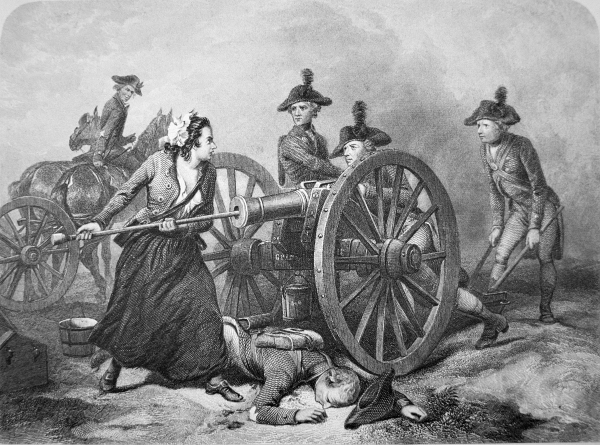Cannons roared alongside the battle cries of men. The clearing was filled with the sting of fighting. As men collided with one another, women ran fast from the clear stream nearby. Bringing water to the men was an arduous, but crucial, part of the battle. One woman had filled her bowl and was walking quickly towards her husband who had just fired another cannon ball at the British line. She listened to the fighting taking place in the clearing, winching at the yelling and screams. Looking up, the bowl of water fell from her hands as she watched her husband crumble to the ground. Picking up the hem of her dress, she sprinted towards him. Collapsing onto her knees, she gently pulled his head into her lap, stroking his hair and caressing his face. She whispered reassuring words to him, but as she watched him and heard the battle persist without thought to her dying husband, anger bubbled inside her. The anger engulfed her with the need to do something, anything. Laying down her husband’s head softly, she walked to the cannon with resolve. She fired the cannon, making it roar with the sound of liberty. Molly Pitcher was a woman who was seen firing a cannon in place of her wounded husband during the Battle of Monmouth. Through her brave act, many have been influenced by her actions.
The Revolution War took many men and did not ignore the women. Women in the war tended to the men, be it camp followers or wives of the soldiers. Such was the case with Molly Pitcher. 1 Many men’s wives followed their husbands into the fighting because it was not safe for the wives to be left alone as the war raged on. Many of the camp followers and wives became water bearers, devoted to bringing water to the soldiers on the battlefield. Many of these women had seen how different weapons and cannons were fired over time because they were around artillerymen the majority of their time. The rare experience of a woman taking over the cannon for her fallen husband was detailed by a soldier and a field doctor that observed the account. Mary Ludwig Hays, or better known as Molly Pitcher of the Battle of Monmouth, was married to her husband who was placed on cannon during the battle. Her husband was then wounded, and she took his place. Her brave action has influenced many women to take action in their lives.

Many women today idolize Molly Pitcher as a role model for women’s empowerment. The Molly Pitcher Project was created in 2013 by four students at the University of Virginia Law School to promote women in combat situations. This project helped with the opening of combat MOs for women who desire to be involved in combat.2 The first woman who completed the project is now an infantry officer among the Army Rangers. This moment was historic for women in the military as well as for young girls who now have a strong woman figure to look up to. Molly Pitcher has become a symbol of power and strength for women and has changed expectations.
Before leaving the battlefield, Pitcher looked over the field one last time and made her way towards her husband. Smoothing his sweaty hair down, she talked to him about how she fired the cannon for him. He smiled up at her face as it mirrored his. Through Molly Pitcher’s bravery and valor, we have a valued piece of history. Women have modeled such actions and courage after her; women were given the power to take on roles in the military, and then partake in combat. Molly Pitcher was a truly brave woman, through her actions women today have a symbol for our own bravery.
- Elizabeth Cometti, “Women in the American Revolution,” The New England Quarterly 20, no. 3 (1947): 344-345. ↵
- “After Challenging Military Ban on Women in Combat, Molly Pitcher Project’s Dreams Are Realized,” University of Virginia School of Law, accessed November 9, 2016, http://www.law.virginia.edu/html/news/2013_spr/pitcher_update.htm. ↵



58 comments
Aaron Jaramillo
Great article. My mother is a very independent woman that I admire and after reading this article I asked her if she had ever heard of Molly Pitcher. Her answer was no. After all what this woman did for women in combat I am surprised that she is not better known with all types of women like other influential historic ladies. Great information about such an influential woman.
Nicolas McKay
I had never heard of Molly Pitcher before, so this was an incredible story to read about. Her story proves not only the immense power and ability that women have, but the potential every ordinary person has when they are given a call to action. Truly inspirational.
Yesenia Cardenas
Well written article! I have read a few articles and short stories on Molly Pitcher while growing up!
Molly Pitcher was such an amazing woman and has inspired thousands of women to stand up for there beliefs.
Mia Diaz
Hell hath no fury like a woman scorned. Even though anger was the emotion which caused Molly Pitcher to take action, I along with other women are sure glad she was motivated enough to take action. In a time when women are constantly looked down upon or are not perceived as having the same capabilities as men, she took the opportunity to do what she thought what was right at the time instead of just feeling sorry for herself and pouting about her life’s tribulations. It is really heartwarming to see how many people were, and still are, inspired by Molly’s action. It is a positive influence to know that just one action can positively affect many people.
Maalik Stansbury
.The amount of empowerment produced by this lady alone was amazing. How she was able to help people and give people that support to fight on no matter who, either male or female, stop them. Great job on explaining the problems that were encountered and how she went through them.
Kassandra Guillen
Very interesting opening paragraph! It immediately caught my attention! This is a great article as it brings forth attention to the prejudices that are faced by women then and even today. Her inspiring character was rightfully showcased as she stayed strong even through her husbands horrible injury. “Molly Pitcher” has become a great model for women as even today we battle with gender barriers socially and in the workplace.
Ivanna Rodriguez
First off, your introduction grabbed my attention right away. It’s incredible to learn that instead of cowering after her husband got shot, Mary had the determination to fire the cannon. Thus, earning the name of Molly Pitcher. Molly Pitcher’s decision to fire the cannon has been an inspiration to women in the armed forces to break gender barriers. It was truly inspiring to read about a woman as courageous as Molly Pitcher. Amazing article!
Elias Melchor
This was a very interesting article. This women had the courage to take her husbands place in the cannon after he was wounded. This shows that women are capable of doing anything they want, even a man’s job if they wanted to. This was a very good article and I hope that this article changes the minds of a lot of young women that read it.
Victoria Sanchez
Your article does a great job of highlighting the prejudices that exist towards women concerning what we can/can’t do, and also the importance of allowing women to step up and take charge. Your introduction presented the story in an interesting light because you talked about the men on the battlefield and the women as water-bearers, so when you bring up the fact about Molly Pitcher getting angry and firing the cannon herself it adds a very interesting shock factor and attention grabber. Overall, I think you do a great job of illustrating how Molly Pitcher and her action serve as inspiration for women to overcome things like sexism and stereotypes. Great job!
Mariana Sandoval
Thanks for shedding light on a women in history that for many, like myself, might be unknown. Even though women tended to the men during war, it’s easy to see that they might have grown tired of seeing their husbands fighting tirelessly while they sat and waited for the next wounded solider to come their way. Not that their job wasn’t important, but it’s easy to see how women might have wanted a more proactive role in efforts to make their husbands jobs slightly easier during this hard time. It’s refreshing to see a women during this time rejecting her accepted societal role and doing what she felt was right. She is an inspiration to many women today who have fought so hard to be able to fight in combat alongside their male counterparts.